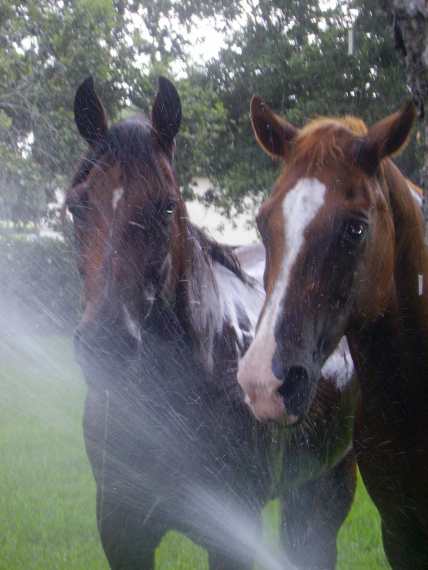Preston R. Buff, PhD; Extension Horse Specialist, Mississippi State University
Summer is upon us and the temperatures in August typically remain elevated during the entire month with little relief. Monitoring animals for heat related problems is important throughout the summer and careful management is critical to reduce the in stances of problems. Generally horses are more heat tolerant animals than cattle. Horses can be found grazing during the middle of the day when cattle are standing in shaded areas and ponds. Sweating is the primary means for horses to regulate body temperature during summer heat. When exposed to elevated temperatures or excessive work, horses will increase their rate of sweating. Endurance trained horses have been reported to lose as much as 7 to 10 percent of body weight per hour when environmental temperatures are elevated. This loss is primarily from water through sweating and can be as much as 30 to 45 quarts. Horses generally do not pant, but will increase their breathing rate when approaching heat exhaustion.
Horses should have access to cool, clean, fresh water at all times. Water consumption by horses is influenced by many factors, such as temperature, humidity, diet and activity. Horses will drink about one pint of water for every pound of feed consumed when the ambient temperature is 0°F and about one gallon for every pound of feed consumed when the ambient temperature is 100°F. Keeping water tanks, buckets and automatic fountains clean will encourage drinking. Horses prefer water kept at temperatures below the ambient temperature during hot weather. Placing water tanks in shaded areas will help maintain lower water temperatures. Stalled horses should be provided with extra buckets during the summer.
When horses sweat they lose body salts (electrolytes) in addition to water. Horses should have free access to salt at all times. Salt can be provided in the block form or loose. A simple electrolyte mixture can be fed to horses that are worked during periods of high temperatures or when horses have an increased rate of sweating. Feeding about two ounces per horse of a mixture of three parts lite salt (potassium chloride) and one part limestone daily will help replace electrolytes which are lost.
The cooling mechanisms of horses are very effective under normal conditions. This is determined by evaluating the ambient temperature and the relative humidity. When the sum of these two factors is less than 130, horses can easily cool themselves. An example of this is when the ambient temperature is 80°F and the relative humidity is 50%, thus the factor would be 130. The ability of horses to effectively maintain proper body temperature decreases when this factor is between 130 and 150. When the factor is above 150 the ability of horses to cool themselves significantly decreases. Once this factor is above 180, horse owners should use caution when exercising horses. When horses are stressed under these conditions the outcome can be fatal.
When horses overheat it is known as hyperthermia or heat exhaustion. This occurs when the horse is unable to effectively cool itself. Hyperthermia can result from hot weather, high humidity, poor ventilation, excessive work load, transport stress, excessive time spent in direct sunlight and obesity. When horses become overheated they can develop muscle tremors, profuse sweating and can collapse. Horses that become overheated should be sprayed with cool water and kept in a shaded, well ventilated area.
Horses that are overheated can develop heatstroke which is a more critical condition. This can occur in horses that perform hard work during hot temperatures. Horses with heatstroke will begin to breath rapidly, become weak, uncoordinated and refuse to work. They will have an elevated temperature and will stop sweating and the skin will become dry. Horses may show signs of delirium and convulsions. The normal vital signs of a horse are 8 to 16 breaths per minute, 32 to 44 heart beats per minute and a rectal temperature of 99.0 to 100.8°F. Horses with heatstroke will have more than 30 breaths per minute with 50 to 100 heart beats per minute and a rectal temperature of 105 to 109°F. Death can occur within a few hours if the horse is not cooled and treated by a veterinarian. The veterinarian should be called to treat any horse showing signs of heatstroke. First-aid treatment to cool the horse should be applied immediately. The horse should be sprayed with cool water and ice packs should be placed on the horse’s head and on the large blood vessels on the inside of the legs. The horse should be kept in a shaded well ventilated area.
Heat cramps result in horses that lose body salts from intense sweating during hard work when ambient temperatures are elevated. Feeding electrolytes daily as outlined above will help prevent heat cramps. Horses afflicted with heat cramps should be cooled, rubbed down and given electrolytes.
To prevent hyperthermia the following management strategies should be followed. Limit strenuous riding to the early morning or late evening when temperatures are cooler. Ensure that stabled horses have adequate ventilation. Remove blankets and sheets from horses during periods of extreme heat. Use fans in barns and stalls and direct the air flow onto horses. Provide shade to horses kept outside. Clip long hair from horses. Transport horses during the coolest part of the day and ensure that trailers are well ventilated. Provide free choice cool, clean, fresh water.
During the hot summer months horses can become overheated easily and should be monitored frequently for the related symptoms. Following the management guidelines outlined in this article will aid in preventing heat related problems. Overheated horses can develop heatstroke rapidly which can result in death if horses are not treated. Contact your veterinarian if you suspect your horse may have heatstroke.
Contact Clovis Livestock Horse Sale

